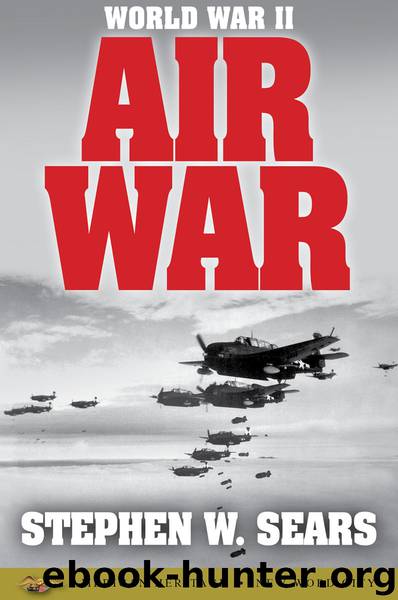World War II: Air War by Sears Stephen W

Author:Sears, Stephen W.
Language: eng
Format: epub
Tags: History/Military/World War II
ISBN: 9781612308777
Publisher: New Word City, Inc.
Published: 2015-05-18T16:00:00+00:00
The savage mauling of the Ploesti raiders was not an isolated incident. Barely two weeks later, the Luftwaffe delivered a second staggering blow at the AAF. Thus began the autumn crisis of the American daylight bombing offensive.
During the summer of 1943, the Eighth Air Force became at last a real threat to the Third Reich. A few months before, the Eighth had been strained to its limits to send off as many as 100 bombers; now raids three times that size were possible.
With this new strength went a new plan, Operation Pointblank. Pointblank’s objective was to so batter Nazi power from the air that an Allied invasion across the English Channel, scheduled for the spring of 1944, could be launched with a better than even chance of success. By night, the RAF would continue its attacks on German industrial centers. By day, the Americans would concentrate on the Luftwaffe, both on the ground and in combat, in an attempt to seize control of the air over the Continent.
In June, July, and early August the U.S. bombers struck at German aircraft engine and fighter assembly plants, rubber factories (which made, among other things, airplane tires), and at airfields in occupied France. On August 13, the Liberators that had survived the Ploesti raid pounded an ME-109 factory in Austria.
The Eighth Air Force unleashed its full power to celebrate the first anniversary of its entry into the air war. On August 17, 1943, exactly one year after the Eighth had sent twelve Flying Fortresses to bomb the rail yards at Rouen, it put into the air 376 B-17s to attack the ball bearing plants at Schweinfurt and the Messerschmitt factory at Regensburg. Never before had the Eighth penetrated so deeply into Germany. Never before had it dispatched so many bombers. And never before had the Luftwaffe reacted so violently.
In selecting these two targets, the American planning staff was going for the vitals of Hitler’s empire. Regensburg assembled about one-third of the Luftwaffe’s ME-109 fighters, and its destruction would cut deeply into the power of Goering’s air force.
The destruction of Schweinfurt might not affect the course of the air war so quickly, but in the long run, it might pay far greater dividends. For Schweinfurt, like Ploesti, was essential to the whole German war effort. Everything from field artillery and precision instruments to airplane engines required ball bearings; the German war machine quite literally rolled on them. About half of these bearings were manufactured in Schweinfurt.
The Eighth dipped into its bag of tricks in planning the double mission. The Regensburg force of 146 B-17s was to take off first, along with American P-47 Thunderbolt fighters to provide escort as far as their limited range allowed. It was hoped that the German fighters would concentrate on this force. To give the bomber crews better odds, the planners decided to have them turn south after hitting Regensburg and land in North Africa rather than try to fight their way back to England. The Fortresses were equipped with extra fuel tanks, and the startled fliers were ordered to pack their toothbrushes.
Download
This site does not store any files on its server. We only index and link to content provided by other sites. Please contact the content providers to delete copyright contents if any and email us, we'll remove relevant links or contents immediately.
The Radium Girls by Kate Moore(10929)
The Templars by Dan Jones(4199)
100 Deadly Skills by Clint Emerson(4095)
Rise and Kill First by Ronen Bergman(4029)
The Doomsday Machine by Daniel Ellsberg(3743)
The Rape of Nanking by Iris Chang(3531)
Killing England by Bill O'Reilly(3468)
Hitler in Los Angeles by Steven J. Ross(3450)
Stalin by Stephen Kotkin(3097)
12 Strong by Doug Stanton(3065)
Hitler's Monsters by Eric Kurlander(2741)
Darkest Hour by Anthony McCarten(2655)
Blood and Sand by Alex Von Tunzelmann(2616)
The Art of War Visualized by Jessica Hagy(2425)
Hitler's Flying Saucers: A Guide to German Flying Discs of the Second World War by Stevens Henry(2306)
The Code Book by Simon Singh(2223)
The Second World Wars by Victor Davis Hanson(2140)
Babylon's Ark by Lawrence Anthony(2079)
Tobruk by Peter Fitzsimons(2069)
